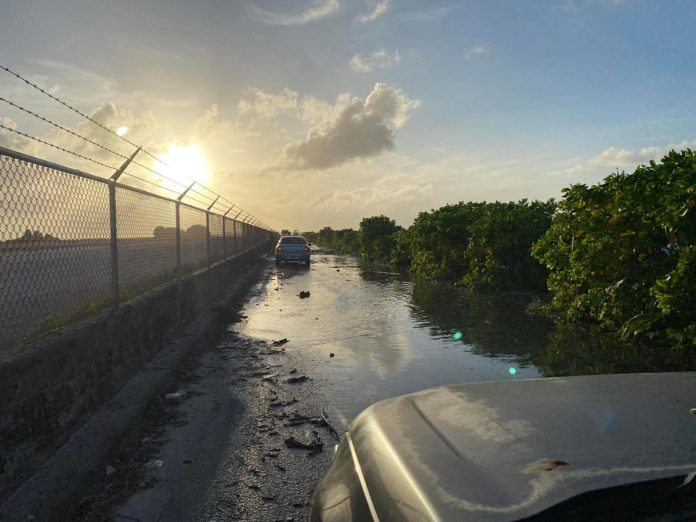Ocean flooding for the third straight day hit low-lying islands throughout the Marshall Islands and the Federated States of Micronesia (FSM), causing sparse damage but requiring large-scale clean-ups in their wake.
Roads by Amata Kabua International Airport in Majuro was down to single lane traffic Monday afternoon as heavy equipment operators moved up and down the long roadway clearing rocks and debris that blocked the road from inrushing tidal water. Waves washing over boulder barriers caused flooding on the roads half a meter deep before receding.
The flooding, which started Saturday and has continued through Monday night, resulted from a combination of ongoing sea level rise, a high tide, and strong winds created by a storm in the vicinity of the Marshall Islands.
Sea level rise is a major contributing factor to the flooding in the Marshall Islands and FSM over the past few days, said a New Zealand-based climate researcher. “An event like this would have been relatively innocuous in the 1990s, but sea level is notably higher today then back then,” said Dr Murray Ford, who is based at Auckland University. “Sea level rise is increasing the frequency and magnitude of these sorts of events.”
Ford said Monday’s inundation came during “the highest tide of the month at 2.14 metres. Monday afternoon, the Weather Service Office in Majuro issued a high surf advisory and warned of “possible inundation and marine conditions hazardous for small crafts. Avoid going near reef lines and beaches.”
Weather officials advised local residents to “take necessary actions to protect your properties and avoid flooded roads and shorelines.”
“I would characterise this event as very high tides – but not the highest of the year – which are higher than predicted due to La Niña, occurring at the same time as some moderate offshore wave heights against a backdrop of sea level that continues to rise at Majuro,” said Ford.
Meantime, in the FSM local residents are reporting widespread flooding.
“Government of the Federated States of Micronesia has been made aware of extensive saltwater inundation across the nation’s islands as a result of ongoing king tides and storm surges,” said the FSM President’s Office in a statement Monday. “The government has received numerous requests from citizens asking for support.”
Photographs from many different islands across the FSM showed flooding in and around people’s homes, roads and shorelines.
The FSM President’s Office advised its “citizens affected by the ongoing flooding activity … to document the event extensively, both with photographs and in writing. Cataloguing the damage and the effects as they occur will assist the state and national government assessments following the event and expedite the issuance of necessary assistance.”
According to tidal gauge measuring equipment installed Majuro in the early 1990s by the Australian government seal level has been rising an average of 4.8 millimetres annually at Majuro. Mean sea level at Kwajalein in October was very close to an all-time record high, said Ford.
No major damage has been reported in Majuro or Ebeye, the two urban centres. On Ebeye, Monday’s high tide pushed water onto sidewalks and “gushed up” over the dock and shoreline protection, said Hilary Hosia, an Ebeye resident.
The Hawaii-based, U.S government-funded Pacific Islands Ocean Observing System (PacIOOS) website forecasts tides to begin dropping after Tuesday night.
SOURCE: MARIANAS VARIETY/PACNEWS














